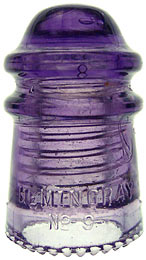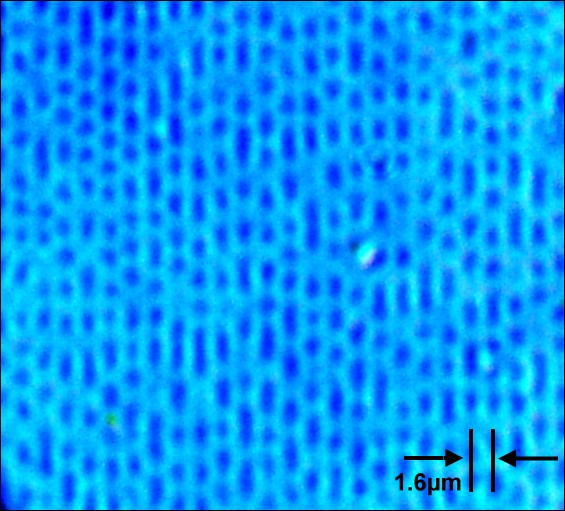|
Hemingray Glass Company
The Hemingray Glass Company was an American glass manufacturing company founded by Robert Hemingray and Ralph Gray in Cincinnati in 1848. In its early years, the company went through numerous and frequent name changes, including Gray & Hemingray; Gray, Hemingray & Bros.; Gray, Hemingray & Brother; Hemingray Bros. & Company; and R. Hemingray & Company before incorporating into the Hemingray Glass Company, Inc. in 1870. The Hemingray Glass Company had factories in Cincinnati and Covington, Kentucky with main production in Muncie, Indiana. Although Hemingray was best known for its telegraph insulators, the company produced many other glass items including bottles, fruit jars, pressed glass dishes, tumblers, battery jars, fishbowls, lantern globes, and oil lamps. In 1933, the Owens-Illinois Glass Company purchased the company but retained the production facility in Muncie under the Hemingray name. The main plant in Muncie closed in 1972 and insulator production ceased. The comple ... [...More Info...] [...Related Items...] OR: [Wikipedia] [Google] [Baidu] |
Pin Insulator
A pin insulator is a device that isolates a wire from a physical support such as a pin (a wooden or metal dowel of about 3 cm diameter with screw threads) on a telegraph or utility pole. It is a formed, single layer shape that is made out of a non-conducting material, usually porcelain or glass. It is thought to be the earliest developed overhead insulator and is still popularly used in power networks up to 33 KV. Single or multiple pin insulators can be used on one physical support, however, the number of insulators used depends upon the application's voltage. Pin insulators are one of three types of overhead insulators, the others being strain insulators and suspension insulators. Unlike the others, pin insulators are directly connected to the physical support compared to being suspended from the wire. Pin insulators are shaped to allow the secure attachment of the conducting wire and avoid it coming adrift. The wire is usually attached to the insulator by being wrapped around i ... [...More Info...] [...Related Items...] OR: [Wikipedia] [Google] [Baidu] |
Aquarium
An aquarium (plural: ''aquariums'' or ''aquaria'') is a vivarium of any size having at least one transparent side in which aquatic plants or animals are kept and displayed. Fishkeepers use aquaria to keep fish, invertebrates, amphibians, aquatic reptiles, such as turtles, and aquatic plants. The term ''aquarium'', coined by English naturalist Philip Henry Gosse, combines the Latin root , meaning 'water', with the suffix , meaning 'a place for relating to'. The aquarium principle was fully developed in 1850 by the chemist Robert Warington, who explained that plants added to water in a container would give off enough oxygen to support animals, so long as the numbers of animals did not grow too large. The aquarium craze was launched in early Victorian England by Gosse, who created and stocked the first public aquarium at the London Zoo in 1853, and published the first manual, ''The Aquarium: An Unveiling of the Wonders of the Deep Sea'' in 1854.Katherine C. Grier (2008) "Pet ... [...More Info...] [...Related Items...] OR: [Wikipedia] [Google] [Baidu] |
CD 125 Hemingray No
The compact disc (CD) is a digital optical disc data storage format that was co-developed by Philips and Sony to store and play digital audio recordings. In August 1982, the first compact disc was manufactured. It was then released in October 1982 in Japan and branded as '' Digital Audio Compact Disc''. The format was later adapted (as CD-ROM) for general-purpose data storage. Several other formats were further derived, including write-once audio and data storage ( CD-R), rewritable media ( CD-RW), Video CD (VCD), Super Video CD (SVCD), Photo CD, Picture CD, Compact Disc-Interactive (CD-i) and Enhanced Music CD. Standard CDs have a diameter of and are designed to hold up to 74 minutes of uncompressed stereo digital audio or about 650 MiB of data. Capacity is routinely extended to 80 minutes and 700 MiB by arranging data more closely on the same sized disc. The Mini CD has various diameters ranging from ; they are sometimes used for CD singles, storing up to 24 minu ... [...More Info...] [...Related Items...] OR: [Wikipedia] [Google] [Baidu] |
CD 124 Hemingray No
The compact disc (CD) is a digital optical disc data storage format that was co-developed by Philips and Sony to store and play digital audio recordings. In August 1982, the first compact disc was manufactured. It was then released in October 1982 in Japan and branded as '' Digital Audio Compact Disc''. The format was later adapted (as CD-ROM) for general-purpose data storage. Several other formats were further derived, including write-once audio and data storage ( CD-R), rewritable media ( CD-RW), Video CD (VCD), Super Video CD (SVCD), Photo CD, Picture CD, Compact Disc-Interactive (CD-i) and Enhanced Music CD. Standard CDs have a diameter of and are designed to hold up to 74 minutes of uncompressed stereo digital audio or about 650 MiB of data. Capacity is routinely extended to 80 minutes and 700 MiB by arranging data more closely on the same sized disc. The Mini CD has various diameters ranging from ; they are sometimes used for CD singles, storing up to 24 minu ... [...More Info...] [...Related Items...] OR: [Wikipedia] [Google] [Baidu] |
CD 122 Hemingray No
The compact disc (CD) is a digital optical disc data storage format that was co-developed by Philips and Sony to store and play digital audio recordings. In August 1982, the first compact disc was manufactured. It was then released in October 1982 in Japan and branded as '' Digital Audio Compact Disc''. The format was later adapted (as CD-ROM) for general-purpose data storage. Several other formats were further derived, including write-once audio and data storage ( CD-R), rewritable media ( CD-RW), Video CD (VCD), Super Video CD (SVCD), Photo CD, Picture CD, Compact Disc-Interactive (CD-i) and Enhanced Music CD. Standard CDs have a diameter of and are designed to hold up to 74 minutes of uncompressed stereo digital audio or about 650 MiB of data. Capacity is routinely extended to 80 minutes and 700 MiB by arranging data more closely on the same sized disc. The Mini CD has various diameters ranging from ; they are sometimes used for CD singles, storing up to 24 minu ... [...More Info...] [...Related Items...] OR: [Wikipedia] [Google] [Baidu] |
CD 121 Hemingray No
The compact disc (CD) is a digital optical disc data storage format that was co-developed by Philips and Sony to store and play digital audio recordings. In August 1982, the first compact disc was manufactured. It was then released in October 1982 in Japan and branded as '' Digital Audio Compact Disc''. The format was later adapted (as CD-ROM) for general-purpose data storage. Several other formats were further derived, including write-once audio and data storage ( CD-R), rewritable media ( CD-RW), Video CD (VCD), Super Video CD (SVCD), Photo CD, Picture CD, Compact Disc-Interactive (CD-i) and Enhanced Music CD. Standard CDs have a diameter of and are designed to hold up to 74 minutes of uncompressed stereo digital audio or about 650 MiB of data. Capacity is routinely extended to 80 minutes and 700 MiB by arranging data more closely on the same sized disc. The Mini CD has various diameters ranging from ; they are sometimes used for CD singles, storing up to 24 minu ... [...More Info...] [...Related Items...] OR: [Wikipedia] [Google] [Baidu] |
CD 113 Hemingray No
The compact disc (CD) is a digital optical disc data storage format that was co-developed by Philips and Sony to store and play digital audio recordings. In August 1982, the first compact disc was manufactured. It was then released in October 1982 in Japan and branded as '' Digital Audio Compact Disc''. The format was later adapted (as CD-ROM) for general-purpose data storage. Several other formats were further derived, including write-once audio and data storage ( CD-R), rewritable media ( CD-RW), Video CD (VCD), Super Video CD (SVCD), Photo CD, Picture CD, Compact Disc-Interactive (CD-i) and Enhanced Music CD. Standard CDs have a diameter of and are designed to hold up to 74 minutes of uncompressed stereo digital audio or about 650 MiB of data. Capacity is routinely extended to 80 minutes and 700 MiB by arranging data more closely on the same sized disc. The Mini CD has various diameters ranging from ; they are sometimes used for CD singles, storing up to 24 minu ... [...More Info...] [...Related Items...] OR: [Wikipedia] [Google] [Baidu] |
CD 107 Hemingray No
The compact disc (CD) is a digital optical disc data storage format that was co-developed by Philips and Sony to store and play digital audio recordings. In August 1982, the first compact disc was manufactured. It was then released in October 1982 in Japan and branded as '' Digital Audio Compact Disc''. The format was later adapted (as CD-ROM) for general-purpose data storage. Several other formats were further derived, including write-once audio and data storage ( CD-R), rewritable media ( CD-RW), Video CD (VCD), Super Video CD (SVCD), Photo CD, Picture CD, Compact Disc-Interactive (CD-i) and Enhanced Music CD. Standard CDs have a diameter of and are designed to hold up to 74 minutes of uncompressed stereo digital audio or about 650 MiB of data. Capacity is routinely extended to 80 minutes and 700 MiB by arranging data more closely on the same sized disc. The Mini CD has various diameters ranging from ; they are sometimes used for CD singles, storing up to 24 minu ... [...More Info...] [...Related Items...] OR: [Wikipedia] [Google] [Baidu] |
CD 106 Hemingray No
The compact disc (CD) is a digital optical disc data storage format that was co-developed by Philips and Sony to store and play digital audio recordings. In August 1982, the first compact disc was manufactured. It was then released in October 1982 in Japan and branded as '' Digital Audio Compact Disc''. The format was later adapted (as CD-ROM) for general-purpose data storage. Several other formats were further derived, including write-once audio and data storage ( CD-R), rewritable media ( CD-RW), Video CD (VCD), Super Video CD (SVCD), Photo CD, Picture CD, Compact Disc-Interactive (CD-i) and Enhanced Music CD. Standard CDs have a diameter of and are designed to hold up to 74 minutes of uncompressed stereo digital audio or about 650 MiB of data. Capacity is routinely extended to 80 minutes and 700 MiB by arranging data more closely on the same sized disc. The Mini CD has various diameters ranging from ; they are sometimes used for CD singles, storing up to 24 minu ... [...More Info...] [...Related Items...] OR: [Wikipedia] [Google] [Baidu] |
Utility Pole
A utility pole is a column or post typically made out of wood used to support overhead power lines and various other public utilities, such as electrical cable, optical fiber, fiber optic cable, and related equipment such as Distribution transformer, transformers and street lights. It can be referred to as a transmission pole, telephone pole, telecommunication pole, power pole, hydro pole, telegraph pole, or telegraph post, depending on its application. A Stobie pole is a multi-purpose pole made of two steel joists held apart by a slab of concrete in the middle, generally found in South Australia. Electrical wires and cables are routed overhead on utility poles as an inexpensive way to keep them insulated from the ground and out of the way of people and vehicles. Utility poles can be made of wood, metal, concrete, or composites like fiberglass. They are used for two different types of power lines: ''sub transmission lines'', which carry higher voltage power between substations, ... [...More Info...] [...Related Items...] OR: [Wikipedia] [Google] [Baidu] |
Telephone
A telephone is a telecommunications device that permits two or more users to conduct a conversation when they are too far apart to be easily heard directly. A telephone converts sound, typically and most efficiently the human voice, into electronic signals that are transmitted via cables and other communication channels to another telephone which reproduces the sound to the receiving user. The term is derived from el, τῆλε (''tēle'', ''far'') and φωνή (''phōnē'', ''voice''), together meaning ''distant voice''. A common short form of the term is ''phone'', which came into use early in the telephone's history. In 1876, Alexander Graham Bell was the first to be granted a United States patent for a device that produced clearly intelligible replication of the human voice at a second device. This instrument was further developed by many others, and became rapidly indispensable in business, government, and in households. The essential elements of a telephone are a ... [...More Info...] [...Related Items...] OR: [Wikipedia] [Google] [Baidu] |
Brazil
Brazil ( pt, Brasil; ), officially the Federative Republic of Brazil (Portuguese: ), is the largest country in both South America and Latin America. At and with over 217 million people, Brazil is the world's fifth-largest country by area and the seventh most populous. Its capital is Brasília, and its most populous city is São Paulo. The federation is composed of the union of the 26 States of Brazil, states and the Federal District (Brazil), Federal District. It is the largest country to have Portuguese language, Portuguese as an List of territorial entities where Portuguese is an official language, official language and the only one in the Americas; one of the most Multiculturalism, multicultural and ethnically diverse nations, due to over a century of mass Immigration to Brazil, immigration from around the world; and the most populous Catholic Church by country, Roman Catholic-majority country. Bounded by the Atlantic Ocean on the east, Brazil has a Coastline of Brazi ... [...More Info...] [...Related Items...] OR: [Wikipedia] [Google] [Baidu] |







